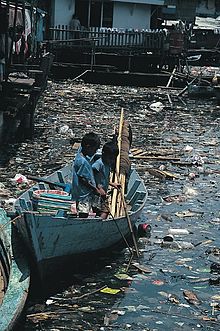
Marine pollution occurs when substances used or spread by humans, such as industrial, agricultural and residential waste, particles, noise, excess carbon dioxide or invasive organisms enter the ocean and cause harmful effects there. The majority of this waste (80%) comes from land-based activity, although marine transportation significantly contributes as well.[1] It is a combination of chemicals and trash, most of which comes from land sources and is washed or blown into the ocean. This pollution results in damage to the environment, to the health of all organisms, and to economic structures worldwide.[2] Since most inputs come from land, either via the rivers, sewage or the atmosphere, it means that continental shelves are more vulnerable to pollution. Air pollution is also a contributing factor by carrying off iron, carbonic acid, nitrogen, silicon, sulfur, pesticides or dust particles into the ocean.[3] The pollution often comes from nonpoint sources such as agricultural runoff, wind-blown debris, and dust. These nonpoint sources are largely due to runoff that enters the ocean through rivers, but wind-blown debris and dust can also play a role, as these pollutants can settle into waterways and oceans.[4] Pathways of pollution include direct discharge, land runoff, ship pollution, bilge pollution, atmospheric pollution and, potentially, deep sea mining.
The types of marine pollution can be grouped as pollution from marine debris, plastic pollution, including microplastics, ocean acidification, nutrient pollution, toxins and underwater noise. Plastic pollution in the ocean is a type of marine pollution by plastics, ranging in size from large original material such as bottles and bags, down to microplastics formed from the fragmentation of plastic material. Marine debris is mainly discarded human rubbish which floats on, or is suspended in the ocean. Plastic pollution is harmful to marine life.
Another concern is the runoff of nutrients (nitrogen and phosphorus) from intensive agriculture, and the disposal of untreated or partially treated sewage to rivers and subsequently oceans. These nitrogen and phosphorus nutrients (which are also contained in fertilizers) stimulate phytoplankton and macroalgal growth, which can lead to harmful algal blooms (eutrophication) which can be harmful to humans as well as marine creatures. Excessive algal growth can also smother sensitive coral reefs and lead to loss of biodiversity and coral health. A second major concern is that the degradation of algal blooms can lead to consumption of oxygen in coastal waters, a situation that may worsen with climate change as warming reduces vertical mixing of the water column.[5]
Many potentially toxic chemicals adhere to tiny particles which are then taken up by plankton and benthic animals, most of which are either deposit feeders or filter feeders. In this way, the toxins are concentrated upward within ocean food chains. When pesticides are incorporated into the marine ecosystem, they quickly become absorbed into marine food webs. Once in the food webs, these pesticides can cause mutations, as well as diseases, which can be harmful to humans as well as the entire food web. Toxic metals can also be introduced into marine food webs. These can cause a change to tissue matter, biochemistry, behavior, reproduction, and suppress growth in marine life. Also, many animal feeds have a high fish meal or fish hydrolysate content. In this way, marine toxins can be transferred to land animals, and appear later in meat and dairy products.
- ^ Sheppard, Charles, ed. (2019). World seas: an Environmental Evaluation. Vol. III, Ecological Issues and Environmental Impacts (Second ed.). London: Academic Press. ISBN 978-0-12-805204-4. OCLC 1052566532.
- ^ "Marine Pollution". Education | National Geographic Society. Retrieved 19 June 2023.
- ^ Duce, Robert; Galloway, J.; Liss, P. (2009). "The Impacts of Atmospheric Deposition to the Ocean on Marine Ecosystems and Climate WMO Bulletin Vol 58 (1)". Archived from the original on 18 December 2023. Retrieved 22 September 2020.
- ^ "What is the biggest source of pollution in the ocean?". National Ocean Service (US). Silver Spring, MD: National Oceanic and Atmospheric Administration. Retrieved 21 September 2022.
- ^ Breitburg, Denise; Levin, Lisa A.; Oschlies, Andreas; Grégoire, Marilaure; Chavez, Francisco P.; Conley, Daniel J.; Garçon, Véronique; Gilbert, Denis; Gutiérrez, Dimitri; Isensee, Kirsten; Jacinto, Gil S. (5 January 2018). "Declining oxygen in the global ocean and coastal waters". Science. 359 (6371): eaam7240. Bibcode:2018Sci...359M7240B. doi:10.1126/science.aam7240. ISSN 0036-8075. PMID 29301986.